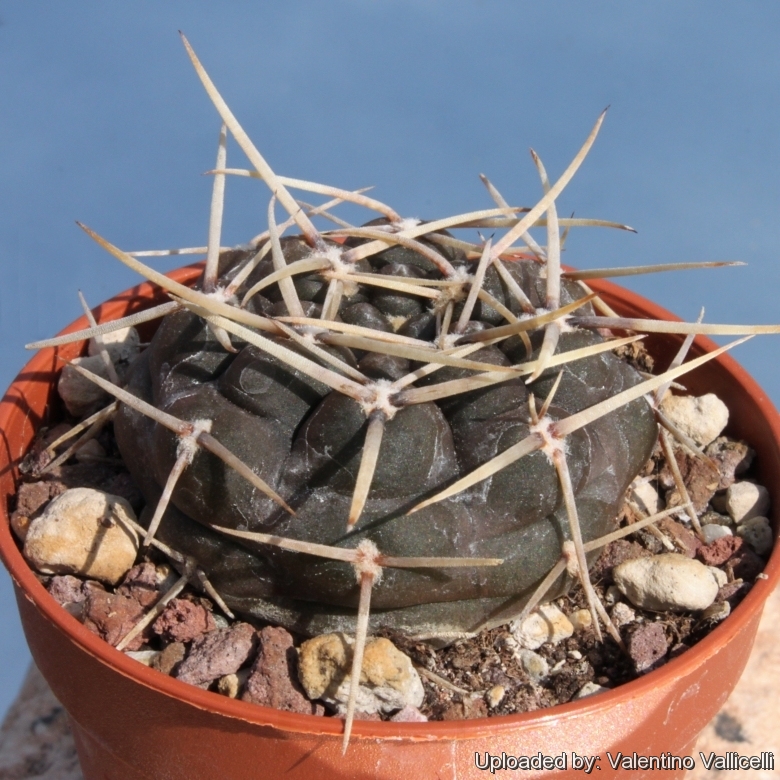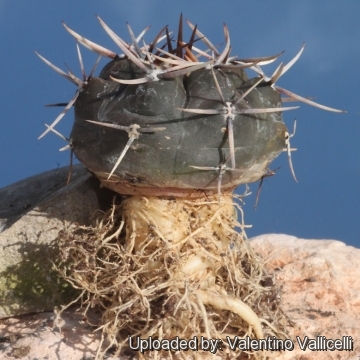Accepted Scientific Name: Gymnocalycium gibbosum subs. borthii (Koop ex H.Till) G.J.Charles
Cactaceae Syst. Init. 20: 18. 2005 [ Nov 2005 ]

Gymnocalycium borthii (Gymnocalycium gibbosum subs. borthii) Photo by: Valentino Vallicelli
P178 Mercedes, San Luis, Argentina, 500m
Origin and Habitat: Near Quines on both slopes of the Sierra de San Luis, San Luis (Provincia), Argentina (South America) Altitude 600 to 800 m.
Synonyms:
See all synonyms of Gymnocalycium gibbosum
Description: Gymnocalycium gibbosumSN|8057]]SN|8057]] subs. borthii is one of the several forms of the very variable Gymnocalycium gibbosumSN|8057]]SN|8057]] which form a complex of related taxon. It is still unclear whether this variable complex is one or several species. There is so much variation that most authors choose to lump them together.
Gymnocalycium gibbosumSN|8057]]SN|8057]]:
Stem: Flattened-globose to elongate, grey-green to purplish-brown up to 9 cm. in diameter and 10 cm. height.
Roots: Semi-tuberose and branched.
Ribs: 9 to 16 vertical with rounded or rarely square chin like projections. Tubercles about 8 mm high, 15 mm wide.
Areoles: slightly recessed, about 20 mm apart, oval, up to 5 mm long and up to 3 mm wide, covered with yellowish-grey felt.
Radial spines: Usually 5 (but occasionally up to 9) flexible to stiff, straight (rarely twisted or bent), radiating more or less diagonally and up to 5 cm. long. One of them is directed downward, and often longer than the other. The spines are very variable in colour, whitish, yellowish at the base and dark grey to brown at the apex but turning grey as they age.
Central spines: Absent.
Flower: Funnel-shaped, laterally near the apex, white to pale violet-pink with a pink-coloured throat up to 4,5 cm. long and 5 cm in diameter. Outer tepals to 20 mm long and 5 mm wide, broadly lanceolate, brownish-coloured, inner tepals 26 mm long and 6 mm wide, lanceolate, sharp-pointed white to bright white, all pink-based. Floral tube dark grey-green to violet brown, covered with numerous small, widely rounded scales. Filament whitish to yellowish, anthers yellow, oval. Pistil (without stigmas) about 12 mm long greenish-yellowish above, with 10 to 13 pale yellow stigma lobes. Nectar chamber widely funnel-shaped, yellowish-pink.
Fruit: Spindle-shaped to barrel-shaped, bluish to whitish (resembles the plant body, but considerably darker) up to 1,5 cm in diameter. Dehiscing on the side lengthwise, pulp is whitish and rather dry.
Seeds: 0,9 to 1,1 mm long and equally broad, ovate, black.
Subspecies, varieties, forms and cultivars of plants belonging to the Gymnocalycium gibbosum group
Gymnocalycium gibbosum has lots of synonyms (like many other Gymnocalyciums) whit several controversial varieties and subspecies and comprises a multitude of different forms, but where each form is linked to others by populations of plants with intermediate characteristics:
 Gymnocalycium gibbosum (Haw.) Pfeiff. ex Mittler: It is a small solitary cactus with deep glaucous-green to grey-black, discoidal stem up to 12 cm in diameter. Flowers in the nearest periphery just around the apex ivory white with a brownish mid rib or occasionally reddish, throat greenish with a basal reddish area.
Gymnocalycium gibbosum (Haw.) Pfeiff. ex Mittler: It is a small solitary cactus with deep glaucous-green to grey-black, discoidal stem up to 12 cm in diameter. Flowers in the nearest periphery just around the apex ivory white with a brownish mid rib or occasionally reddish, throat greenish with a basal reddish area. Gymnocalycium gibbosum subs. borthii (Koop ex H.Till) G.J.Charles: has dark green, round, low ribs with tubercles, large white flowers. Distribution: Quines, San Luis, Argentina
Gymnocalycium gibbosum subs. borthii (Koop ex H.Till) G.J.Charles: has dark green, round, low ribs with tubercles, large white flowers. Distribution: Quines, San Luis, Argentina Gymnocalycium gibbosum var. brachypetalum (Speg.) Papsch: has grey-black body and large white flowers. Distribution: La Pampa and Río Negro Argentina.
Gymnocalycium gibbosum var. brachypetalum (Speg.) Papsch: has grey-black body and large white flowers. Distribution: La Pampa and Río Negro Argentina. Gymnocalycium gibbosum var. chubutense (Speg.) Papsch: has dark green to nearly black stem and cream-white or pinkish flowers. Chubut, Peninsula Valdes, Argentina
Gymnocalycium gibbosum var. chubutense (Speg.) Papsch: has dark green to nearly black stem and cream-white or pinkish flowers. Chubut, Peninsula Valdes, Argentina Gymnocalycium gibbosum f. cristatum hort.: crested form.
Gymnocalycium gibbosum f. cristatum hort.: crested form. Gymnocalycium gibbosum subs. ferox (Labour. ex Rümpler) Papsch: has very robust radial spines and no centrals. Distribution Chubut province.
Gymnocalycium gibbosum subs. ferox (Labour. ex Rümpler) Papsch: has very robust radial spines and no centrals. Distribution Chubut province. Gymnocalycium gibbosum f. longispinum hort.: The form “longispinum” has longer and stiffer spines but is practically identical to the normal form in stem and flowers characteristics. (Only known in cultivation)
Gymnocalycium gibbosum f. longispinum hort.: The form “longispinum” has longer and stiffer spines but is practically identical to the normal form in stem and flowers characteristics. (Only known in cultivation) Gymnocalycium gibbosum var. nigrum Backeb.: has very dark green to almost black stems.
Gymnocalycium gibbosum var. nigrum Backeb.: has very dark green to almost black stems. Gymnocalycium gibbosum var. nobile (Haw.) Y.Itô: This variety is easily recognized by the very dark olive-green body and the strong, more numerous, longer, overlapping, spines that are white with a darker base.
Gymnocalycium gibbosum var. nobile (Haw.) Y.Itô: This variety is easily recognized by the very dark olive-green body and the strong, more numerous, longer, overlapping, spines that are white with a darker base.
Bibliography: Major references and further lectures
1) Edward Anderson “The Cactus family” Timber Press, Incorporated, 2001
2) James Cullen, Sabina G. Knees, H. Suzanne Cubey "The European Garden Flora Flowering Plants: A Manual for the Identification of Plants Cultivated in Europe, Both Out-of-Doors and Under Glass" Cambridge University Press, 11/Aug/2011
3) David R Hunt; Nigel P Taylor; Graham Charles; International Cactaceae Systematics Group. "The New Cactus Lexicon" dh books, 2006
4) N. L. Britton, J. N. Rose “The Cactaceae. Descriptions and Illustrations of Plants of the Cactus Family.” Volume 4, The Carnegie Institution of Washington, Washington 1923
5) Curt Backeberg “Die Cactaceae: Handbuch der Kakteenkunde” Gustav Fischer Verlag, Stuttgart New York 1982–1985
 Gymnocalycium borthii (Gymnocalycium gibbosum subs. borthii) Photo by: Valentino Vallicelli
Gymnocalycium borthii (Gymnocalycium gibbosum subs. borthii) Photo by: Valentino VallicelliSend a photo of this plant.The gallery now contains thousands of pictures, however it is possible to do even more. We are, of course, seeking photos of species not yet shown in the gallery but not only that, we are also looking for better pictures than those already present.
Read More... Cultivation and Propagation: Gymnocalycium gibbosumSN|8057]]SN|8057]] is a summer grower species that is easy to cultivate.
Growth rate: It is a relatively rapidly growing and easily flowering species that will make clumps given the best conditions.
Soils: It likes very porous standard cactus mix soil. Prefer a low pH compost, avoid substrata rich in limestone; otherwise growth will stop altogether.
Repotting: This plant needs plenty of space for its roots, repotting should be done every other year or when the it has outgrown its pot. Use pot with good drainage.
Watering: Needs moderate to copious waterings in summer, but do not overwater (Rot prone), keep dry in winter at a minimum temperature of 0°C.
Fertilization: Feed with a high potassium fertilizer in summer.
Hardiness: Reputedly resistant to frost if kept on the dry side prior to, and during, cold weather (hardy to -12 C ° C, or less for short periods), but for safe cultivation it is best to avoid freezing temperatures.
Exposition: The plant tolerates extremely bright situations but enjoys filtered sunlight or afternoon shade, inside it needs bright light, and some direct sun. Tends to bronze in strong light, which encourages flowering and heavy spine production, but is likely to suffer from sun scorch or stunted growth if over exposed to direct sunlight during the hottest part of the day in summer.
Uses: It is an excellent plant for container growing. It always looks good and stays small. It look fine in a cold greenhouse and frame or outdoor in a rockery.
Pests & diseases: It may be attractive to a variety of insects, but plants in good condition should be nearly pest-free, particularly if they are grown in a mineral potting-mix, with good exposure and ventilation. Nonetheless, there are several pests to watch for:
- Red spiders: Red spiders may be effectively rubbed up by watering the plants from above.
- Mealy bugs: Mealy bugs occasionally develop aerial into the new growth among the wool with disfiguring results, but the worst types develop underground on the roots and are invisible except by their effects.
- Scales: Scales are rarely a problem.
- Rot: This species is particularly easy and accommodating, seldom suffer of cryptogamic diseases. Rot it is only a minor problem with gymnocalyciums if the plants are watered and “aired” correctly. If they are not, fungicides won't help all that much.
Propagation: Seeds (It don't produces offsets). Seeds germinate in 7-14 days at 21-27° C in spring, remove gradually the glass cover as soon the plants will be well rooted (ca 1-2 weeks) and keep ventilated, no full sun for young plants!
Seed Collecting: Permit fruit to ripen, fruit must be significantly overripe before harvesting seed; clean and dry seeds.











